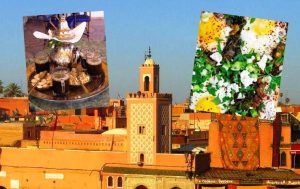The plant is widely used in traditional medicine to treat and prevent a wide range of diseases like dementia, Alzheimer, gastrointestinal disorders, as well as epilepsy, headache, asthma, inflammation, and malaria.
Dichrocephala integrifolia (Family Asteraceae) is an upright or spreading, aromatic annual plant growing to an average of 40cm in height. It often branches freely at the base, though can be unbranched, and forms new roots at the leaf nodes. Leaves are usually obovate or ovate or lance-shaped, with lateral lobes in 1 or 2 pairs.
Flower-heads are few, spherical, 3-6 mm across, on slender diverging flower-cluster-stalks. Ray florets are pinkish or white and disc florets are yellow. The fruit is hypochlorous with seed pods measuring about 1 mm long and smooth or with fine velvet hair. Dichrocephala integrifolia is native to Africa and found in grassland and semi-shaded areas.
Dichrocephala integrifolia is widely used in traditional medicine to treat and prevent a wide range of disease conditions including dementia, Alzheimer, gastrointestinal disorders, diarrhoea, hepatitis, worm infections, amebiasis and some central nervous system illnesses. It is also used in a number of communities during tooth extractions and to treat schizophrenia, wounds, epilepsy, headaches, asthma, inflammation, malaria, jaundice, filariasis, neuritis and children’s night agitation. It is also known to have anxiolytic properties.
The infusion of the whole plant is administered to treat memory impairment and hepatic disorders. In Central Africa, the plant is used for the treatment of eye diseases, intestinal worms, and leishmaniasis. In East Africa, the plant is commonly used in the treatment of skin infections. A decoction made from the whole plant has been used as emetics, purgatives, antitumor and for the management of liver, spleen, kidney, bladder, bone, and joint diseases. A paste is made by pounding the whole plant as an antidote for a snake bite.
The plant juice is used as a treatment against filariasis and malarial fevers. It can also be applied in the nose to treat sinusitis and migraine. The dried and powdered plant is applied as a dressing on old, infected wounds to improve healing and the juice of the plan is used to quicken the healing process. Dichrocephala integrifolia is used as a therapy for hypertension, inflammatory diseases, stomach ulcers, and liver dysfunctions. Its young shoots are also used as poultice for treating blennorrhagia and insect stings, spiders, or scorpions.
The concentrated liquor prepared from its leaves is used in the treatment of Alzheimer and dementia diseases. Fresh leaves and stems are used as aesthetic in atraumatic tooth extraction. The leaves are antiviral, and can be crushed to treat ulcers and swellings. It is placed on the fractured, painful, or carious teeth for two to three minutes, causing it to become loose, and then pulled. The sap from the crushed leaves is reapplied to the extraction site to enhance clotting and stop bleeding.
The leaf infusion is used by traditional healers in the treatment of oxidative stress disorders and memory loss. The aroma of the crushed flower heads is inhaled to induce sneezing and thus helps to reduce nasal congestion.
The medicinal potential of Dichrocephala integrifolia may be attributed to its various phytochemicals, including diterpene lactones, sesquiterpenes lactones, sterols, dichrocephol, dicaffeoylquinic, saponins, alkaloids anthraquinones, and flavonoids. The plant contains flavonoids such as rutin, which exhibits great pharmacological activities and is known as a ‘capillary protectant’. Dichrocephala integrifolia is also used to treat cattle for swelling, infection, necrosis, edema, and pain.
(Richard Komakech – Photo: CC BY-SA 3.0/Fagus)








